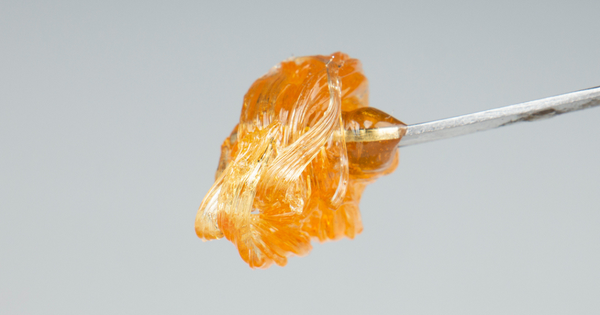Is CRC Bad for You?
Jan 18, 2024
Cannabis concentrate production continually evolves, bringing forth new technologies that promise enhanced quality and purity. One innovation at the forefront of this evolution is CRC (color remediation column) technology.
While CRC has stirred a mix of opinions in the cannabis community, it's essential to understand its role and impact beyond just improving an extract’s color and clarity.
What Are CRC Dabs?

CRC dabs refer to cannabis concentrates that have undergone a filtration process using CRC technology. This purification method involves passing the concentrates through a blend of filtration media, typically made of materials like silica, bentonite clay, or activated charcoal.
The primary goal of CRC is to remove impurities, unwanted coloration, and other contaminants from the cannabis extracts, resulting in a purer, more refined product.
The use of CRC technology in the production of dabs has become increasingly popular for its ability to enhance the concentrates' clarity, flavor, and overall quality.
By filtering out excess plant lipids, chlorophyll, and other undesirable substances, CRC dabs offer users a cleaner and potentially more potent experience.
If used correctly, this technology not only preserves the essential cannabinoids and terpenes but also ensures a higher level of purity and safety in the final product, maintaining the true essence and effectiveness of the original plant material.
Are CRC Dabs Bad?

The use of CRC technology in cannabis extraction has sparked a significant debate among consumers, producers, and health experts. At the heart of this discussion is the question: Are CRC dabs bad?
To understand the different perspectives, looking at both the benefits and concerns associated with this technology is essential.
Misuse and Quality Concerns
A notable critique of CRC technology is the potential for its misuse in disguising the quality of the starting cannabis material. Some argue that CRC can be used to polish low-grade cannabis oil, making it appear higher in quality than it actually is.
This concern stems from the ability of CRC to significantly improve the color and clarity of concentrates, often perceived as quality indicators.
While there may be bad actors, particularly in the traditional market, that use CRC to improve the look and taste of poor-quality, unregulated, and possibly harmful cannabis, this isn’t the case by and large.
In response to these concerns about misuse, many ethical producers use CRC not to disguise quality but to enhance the purity and safety of their products genuinely. They start with high-quality cannabis material and use CRC to refine their extracts further.
These producers are transparent about their use of CRC technology, providing consumers with information about the origin and quality of the starting material. CRC is used not as a means to upsell inferior products but as a legitimate technique to refine and enhance the quality of the concentrates. With this technology, producers can both dial in the color and flavor of high quality extracts and dramatically improve the bitter taste and harsh experience of aged cannabis by removing unwanted compounds.
Educating consumers about the nuances of CRC technology and its application is vital. Consumers can make more informed decisions by understanding that CRC is a tool for enhancement rather than disguise.
The industry is increasingly focusing on consumer education, helping to dispel myths and misunderstandings about CRC and its role in cannabis concentrate production.
Lack of Standardized Regulation
The absence of unified, industry-wide regulations specifically for CRC technology poses significant challenges. This lack of standardization results in varied application methods, filtration media usage, and testing practices.
Without consistent guidelines, the quality and safety of CRC-processed products can vary significantly from one producer to another, potentially leading to consumer uncertainty and mistrust.
In the face of these regulatory gaps, many conscientious manufacturers have taken a proactive approach. For example, at Media Bros, we implement rigorous testing protocols that go well beyond basic compliance.
We ensure that all media used in the CRC process undergoes thorough testing and adheres to strict standards, often following FDA or NSF certification guidelines. This commitment ensures the safety and quality of their products and sets a benchmark in the industry.
Health and Safety Concerns
The primary concern with CRC technology is the potential respiratory damage from inhaling filtration materials like bentonite clay, diatomaceous earth, and silica gel.
While these risks are documented in industrial settings due to high exposure levels, it’s crucial to distinguish these scenarios from CRC processing. In CRC, the careful and precise use of filtration materials minimizes the risks associated with inhalation for extractors when handled during manufacturing; and, virtually eliminates any risk of inhalation or consumption in the finished extracts.
Additional worries pertain to potential contaminants, such as heavy metals in bentonite clay, which could pose health risks if not adequately controlled during extraction. The extraction process uses specialized filters capable of capturing these tiny particles.
Proper CRC processing, particularly using final micron-sized filters, is key in ensuring no trace of media is left in the finished product. Products like Media Bros' Ulti-Filter are specially designed to capture any residual amounts, ensuring the purity of the final extract.
Many high-quality CRC media products are also generally recognized as safe (GRAS) by the FDA. This certification adds an extra layer of assurance regarding the safety of these materials when used in CRC processing.
How to Tell if Your Dabs Are CRC

Identifying whether your cannabis concentrates have been processed using CRC technology can be important for both personal preference and informed consumption. While there’s no surefire way to tell whether extracts have undergone CRC, there are some signs you can look for.
Here are some key indicators that can help you determine if your dabs have undergone CRC treatment:
- Color and Clarity: CRC extracts often exhibit a lighter color, ranging from pale yellow to almost transparent. This is due to removing impurities and colorants during the CRC process. If your dabs are remarkably lighter than typical concentrates, they might have been processed with CRC.
Filter Media Sample Request
Interested in trying our filter media? We would love to send you some! Browse our products, then fill out this form and someone from our team will be in touch to finalize your request.
A New Era of Enhanced Cannabis Quality
CRC technology showcases the dynamic and innovative spirit of the cannabis industry. As we embrace new technologies like CRC, we open the door to purer, higher-quality concentrates that enhance the user experience.
By navigating these advancements with an informed and positive outlook, both consumers and producers can look forward to a future where quality, safety, and enjoyment go hand in hand in the world of cannabis concentrates.







